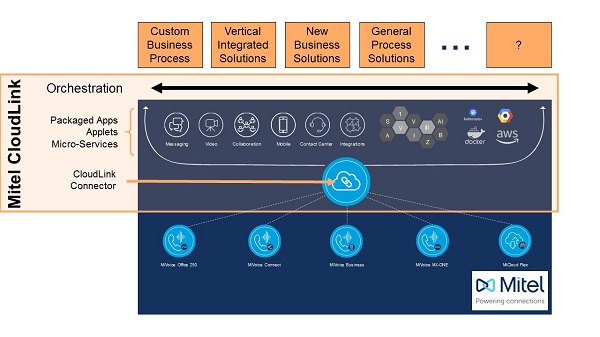Having attended a Mitel analyst briefing a few weeks ago, I began writing an article with my perspective on the company’s strategy and place in the industry. But since I started writing, the industry changed, and I had to take a pause to consider the impact.
First,
Avaya announced an exclusive partnership with RingCentral, with a goal of facilitating its customers’ migration to that UCaaS platform; RingCentral has invested in Avaya, too. And last week, Mitel announced that Mary McDowell joined the company as CEO, replacing Rich McBee in that role. However, I’ve concluded that these moves don’t change the market or Mitel’s challenges.
In this article, I’m focusing in on the key area where Mitel needs to win for overall success.
A CEO’s Legacy
A well-understood fact in the communications industry is that Mitel, under McBee’s tenure, had a strategy of “rolling up the category” by acquiring installed bases of premises-based PBX/IP-PBX equipment at relatively low per-seat cost. Also known is that the company’s challenge is in delivering enhanced value to that installed base, now between 60 and 70 million seats. With the $1.1 billion in premises revenue Mitel reported for 2018, the installed base accounts for about $1.60 of revenue per seat per month.
Clearly, the market and the large installed base presents opportunities for Mitel to offer services that would attract higher revenue per active seat, validating its overall strategy. Cloud communications/UCaaS companies like RingCentral are reporting per-seat revenues of over $25 per month, more than 15 times the Mitel premises revenue. This is why RingCentral, along with Zoom Communications and others, receive high valuations in the stock market. For Mitel’s plan to succeed, the average revenue per user (ARPU) must increase.
Overall, Mitel discussed three strategic directions I believe are critical to achieving the goal of increasing ARPU and succeeding in the cloud transition:
- Increase value and income from the installed base
- Create a cloud migration advantage for existing customers
- Overcome challenging environment to win new cloud customers
Let’s examine how Mitel is responding in each area and the path to success its response opens.
Installed Base Increased Value and ARPU
Creating value for the installed base is a clear imperative of Mitel’s acquisition strategy, as evidence in its CloudLink platform strategy for bringing value-adds to the range of PBX products it supports. While the CloudLink name implies connectivity, this is really a framework for enabling a platform market structure. The diagram below, with the blue portion provided by Mitel, shows the technical framework.
On the bottom are the range of Mitel communications/PBX systems supported. CloudLink has a connector component that provides the link from all underlying systems to the new cloud-based application and micro-services layer. This layer, built and deployed in modern cloud paradigms, includes a rapidly growing set of enhanced communications and collaboration elements, including contact center, but also a range of microservices and applets that can be integrated into and assembled with existing and new business process/application/communications solutions. For example, a rapid team formation microservice can be combined with available personnel and location information to build a first provider rapid response system.
Mitel has been developing these microservices and has a number of microservices and applets, including Internet of Things (IoT) integration, ready for market use. The resulting business solutions are illustrated by the orange boxes I added on the top. This level represents some areas where integration with a business process may occur.
Mitel has been working and demoing CloudLink for a couple of years, and the platform now appears poised for prime time — at least based on what I’ve seen at this event and elsewhere. In fact, it demonstrated an orchestration layer, as the diagram shows. This is a drag-and-drop application development environment that enables rapid prototyping and delivery of communications services with a range of workflows and applications.
Beyond selling advanced UC apps and services, the key to long-term business value is getting partners to integrate communications into business processes/applications using the CloudLink platform. This can happen in many ways. One that is interesting, but challenging, is using the existing channels. This will require an active program to develop the capabilities to identify potential opportunities at a business level and integration into business software. An alternative is to work with enterprise software vendors to integrate communications into applications based on the verticals addressed. Mitel has been working in the health care space with vendors like Epic to drive this path.
Installed Base Path to Cloud
Historically, the traditional PBX market saw 5% churn and 5 to 10% major upgrades annually. As a result, every 20 years a site would go to a new vendor. So, buying an installed base comes with the presumption of an average life of 10 years, as the average customer would be halfway through the 20 years. At the Mitel average of $1.60 per month for those 10 years, the total value of an average acquired PBX premises seat is about $192 of total revenue.
As always when discussing the cloud migration, my definition of “moving to the cloud” is transitioning to a monthly subscription revenue model, regardless of hosting venue or tenancy type. The new UCaaS offers that are designed using modern cloud models enable rapid innovation using the cloud delivery model. However, for many premises customers, sticking with a premises solution for telephony seems to be the current choice. That’s where CloudLink comes in. The benefits of using the modern cloud models aren’t necessary to get cloud recurring revenue for basic telephony as included in Mitel MiVoice Flex. In this world of cloud transitions, Mitel is best served if there’s a compelling story for an installed base Mitel customer to move to the cloud using a Mitel cloud solution, either single tenant or UCaaS.
Mitel has achieved success in this regard for the 6900 Series IP phones, which can work across the premises range and into cloud phone systems such as MiCloud Connect. The ability to migrate newer IP phones to the cloud could be a significant advantage for some customers.
Mitel also has identified user experience and training as other benefit areas, as well as familiarity and comfort with Mitel and the channel representatives. Overall, this is an area where clear focus is required to channel UCaaS transitions from the base to the Mitel UCaaS offers.
Winning New Logos in the Cloud
Uptake of UCaaS cloud-based solutions (read definition above) is significant, with most analyst projections showing revenue and subscriber growth rates of 20 to 30% today. As the UCaaS market is in rapid growth range, the competition to get new subscriber seats is high. Based on analysis of public UCaaS company results, the cost of customer acquisition has ranged to over $500 per seat, with break-evens on the customer acquisition at 20 months or more. Vendors are paying signing bonuses of six months revenue or more to the channel on signing a new contact. Growth in in the open SMB market is brutal.
For Mitel, the first line of attack is the channel, something that it emphasized at the recent event. But, what about the brand awareness that’s so essential in the modern customer journey? For Mitel, without the ability to lose money, running ads incessantly is a challenge. Enter the relationship Mitel forged in 2018 with Major League Baseball (MLB), for which it is the official business technology and communications partner, providing all baseball communications (dugout, press room, video, etc.). Mitel attributes a 29% increase in brand awareness, a critical factor for early inclusion in consideration and prospect identification, to the MLB partnership.
The challenge of attracting customers among new cloud buyers can't be discounted, and Mitel must clearly define its offers and market strategy here if it expects to succeed. Toward that end, Mitel discussed an initial low-touch retail/channel product that integrates with CloudLink for key delivery values. The solution has interesting scaling though modular software that makes each user a microservice instance.
Mitel’s strategy, and its impact, for winning new customer transitions will become clear over the next year.
Final Impressions
First, I wish McBee the best. He defined and executed a strategy that has moved Mitel into the top tier of vendors in the space. During my interactions with the Mitel team over the last four to five years, the core strategy hasn’t changed: Acquire lower-cost premises assets and migrate the base to the cloud, either for added value functions to the premises system or for cloud-based UCaaS. At the meeting, it was clear that the strategy is continuing, and the team is delivering in many areas. The cloud value proposition of CloudLink appears ready, the next step of market adoption is critical.
Second, a welcome to McDowell. With the Avaya base off the market and no sign NEC or Atos/Unify want to sell, the days of base rolling may be over. PKE Consulting analysis shows Mitel has 13 to 15% of the global premises’ PBX installed base. Delivering on a strategy that increases ARPU in that base and raises the odds of migration to the cloud with Mitel is critical. Having phone interoperability and easy cloud migration is now part of the offer. Over the next year, the focus on the installed base migration will accelerate.
Unless a new strategy or sale emerges, the challenge for McDowell and the Mitel team for 2019 and 2020 appear to be about execution and delivery. Delivering value to and retaining the base through cloud migration will be critical. Delivering on the business values in CloudLink is critical, both for the base as well as to create value propositions to compete in the more general cloud migration/UCaaS market. I look forward to seeing how Mitel brings the opportunity, strategy, and execution together.











